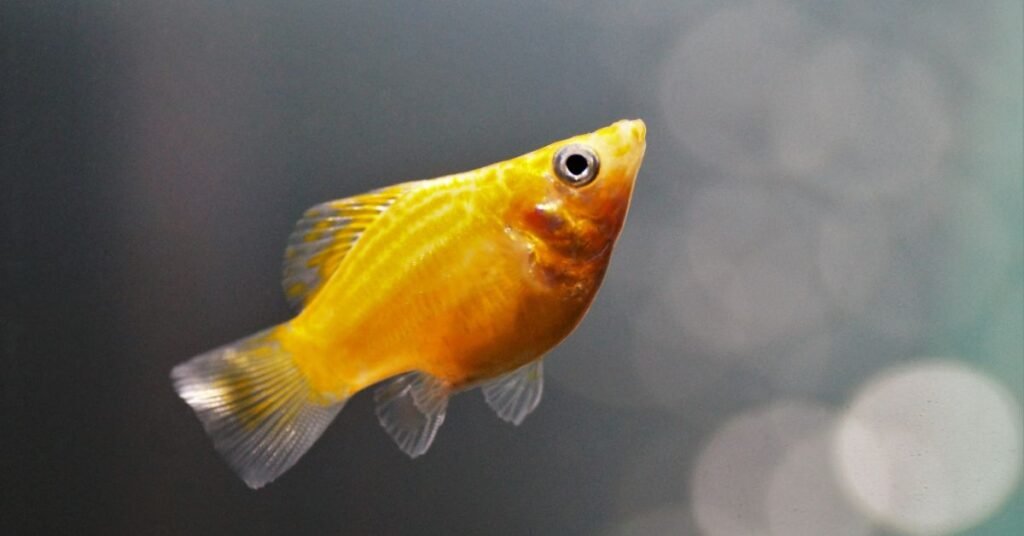Not sure if your pregnant molly fish is showing signs? Don’t worry. It’s easier to tell than you might think. From changes in her belly shape to her behavior, there are clear signs to watch for. This simple guide walks you through what to expect and how to care for your Molly every step of the way. Whether you’re new to fish keeping or just curious, you’ll feel ready to help your molly through pregnancy with confidence and ease.
Table of Contents
Pregnant Molly Fish Behavior
Seclusion: Pregnant moles often seek hiding places in something. They prefer secluded areas to avoid pressure from other fish. This indicates their instinct to protect themselves and the developing fry.
Decreased activity: Molly becomes less active as pregnancy progresses. You’ll often see her resting near the bottom of the tank or tucked beside plants and decorations. She’s not being lazy, just saving energy while carrying her babies.
Nesting Behavior: Pregnant moths exhibit nesting behavior while giving birth. The young try to find a safe place near the substrate or in the vegetation to avoid potential threats.
Changes in appetite: During this time, they often experience fluctuations. Pregnant Molly fish may eat more because of the increased metabolic demand early on. However, this may decrease significantly as the birth stage progresses.
Increased Aggression: During this time, pregnant moths are usually aggressive towards tank mates. This may be a protective instinct as they prepare for their baby’s arrival.
How Long Are Molly Fish Pregnant?
A pregnant Molly fish usually stays pregnant for about 30 to 40 days, but it can vary by species. Black mollies and white cellophane mollies often follow this timeline closely.
Here’s a quick look by type:
- Common Black Molly: Around 30 days
- White Selfin Molly: As short as 21 days
- Black Cellophane Molly: About 40 days
- Dalmatian Molly: Longer pregnancy—about 50 to 70 days
Once the pregnancy ends, Molly gives birth within a day. She can have anywhere from 20 to 100 tiny fry at once, depending on her species and health.
Female mollies can store sperm for months. They can have babies even without a male nearby. So, you might see little fry surprises often.
Pregnant Molly Fish Stages
Watching a pregnant Molly fish grow her babies is exciting. It feels a bit like magic. Here’s how it all happens, step by step.
Conception
It starts when a male molly fertilizes the female’s eggs. But here’s something wild- she can store that sperm for months! Even without a male around, she can keep making babies later on. It’s like she has her own backup supply.
Embryo Formation
About a week after mating, the fertilized eggs turn into tiny embryos. You’ll notice the gravid spot near her anal fin gets darker. That’s one of the first signs your Molly is truly pregnant.
Fry Development
As the babies grow, her belly swells up. It starts out round, but as birth gets closer, it turns more square. She might swim less and hang out near the bottom of the tank, which is totally normal.
Pre-Birthing
At this stage, the fry are fully formed and ready to be born. If you look closely, you might even see tiny eyes inside her belly. She may act restless, stop eating, or try to find a quiet spot. She knows it’s almost time.
Birth
Finally, she gives birth, usually at night or when the lights are dim. The fry swim right away, but Mom often hides them to keep them safe.
Pregnant Molly Fish Symptoms
Is your Molly expecting? Here are the most common signs to look for when spotting a pregnant molly fish.
- Growing belly—Her belly gets rounder and starts to look more square as the babies grow.
- Dark gravid spot—You’ll notice a dark patch near her anal fin. It gets darker as her pregnancy goes on.
- Slower movement—she may rest more and avoid fast swimming. It’s her way of saving energy.
- Changes in appetite—Some pregnant mollies eat less right before giving birth.
- Hiding behavior—As she nears delivery, she looks for quiet spots. She might stay near decorations.
- Visible baby fish eyes—In the final days, you might see tiny eyes inside her belly. It’s both strange and amazing!
Every Molly is a bit different. But if you see a few of these signs, your fish is likely about to have babies.
Balloon Molly Pregnant
When you’re pregnant, Molly fish is ready to have babies; her belly grows bigger. It also looks more square than before. You can easily tell this change from a normal female molly. You might see her stop and rest by plants or decorations. She’s saving her energy for when she has to carry her babies.
A pregnant Molly fish’s gravid spot is a black area near her anal fin that indicates she is pregnant. As her pregnancy goes on, this spot gets darker and easier to see. It’s like a little badge that you can see grow as you get pregnant.
Balloon mollies usually have round bellies. So, when their belly gets bigger and squarer, it really stands out. You’ll see this change especially in the last weeks before she gives birth.
How Many Babies Do Mollies Give Birth To?
Pregnant Molly fish can give birth to anywhere from 20 to 100 babies at a time, sometimes even more. The number depends on Molly’s size, age, and overall health. Younger mollies have fewer babies. Older, healthy females can fill the tank with fry. Don’t be shocked if it happens overnight. One minute you’re going to bed, and the next morning, there’s a swarm of tiny swimmers zipping around your tank.
Also, here’s a heads-up: mollies don’t always wait long between births. Since females can store sperm, they can give birth again and again, even without a male in the tank!
When to Separate a Pregnant Molly Female?
Separate a pregnant molly fish female when her belly is big and square. You should also see the dark gravid spot clearly. If she starts hiding more, stops eating, or looks restless, she’s likely getting close to giving birth.
That’s your cue to gently move her to a breeder box or a separate tank. Don’t wait too long; if you move her too late, she might give birth in the main tank, and the fry could get eaten. If you move her too early, it can stress her out.
Think of it like getting the nursery ready, timing is everything! Watch her closely, and trust your gut. After a few pregnancies, you’ll start to recognize the signs.
Can I Move a Pregnant Molly Fish to a New Aquarium?
Yes, you can move a pregnant Molly fish to a new aquarium, but do it carefully. Ensure the new tank is clean, has a stable water temperature, and provides ample hiding spots. Avoid sudden changes to reduce stress. Moving her gently will help keep her calm and support a healthy pregnancy and safe delivery of the fry.
How to Take Care of Pregnant Molly Fish
Taking care of a pregnant Molly fish is pretty simple once you know what she needs. Start by giving her a calm, quiet space in the tank with live plants, caves, or decorations that help her feel safe.To keep your Molly fish healthy, focus on clean water and make sure you understand how to clean an aquarium without stressing them.
Do small water changes often. Keep the water temperature at 78°F. Feed her flakes, pellets, and protein treats. Try brine shrimp or bloodworms to keep her strong. Avoid stressing her out with sudden changes or aggressive tank mates.
As she gets closer to giving birth, you might notice her hiding more or moving less; that’s totally normal. After she has the babies, try to move the fry to a separate tank or breeder net to keep them safe. Mollies are fun to watch during pregnancy, and with a bit of care, you’ll have healthy fry in no time.

Final Thought
You don’t have to make caring for a pregnant Molly fish complicated. Just watch for the signs, like a swollen belly, dark gravid spot, and changes in behavior. Make sure she has clean water, good food, and a calm space to rest. And when the time comes, be ready for a tank full of tiny fry! With good care, your Molly will have a healthy pregnancy. Then, you get to enjoy a new life in your tank.
What does a Pregnant Molly Fish look like?
A pregnant Molly fish usually has a round and boxy, bloated belly. A black, gravid patch near the anal fin indicates a growing fry. Pregnant mollies may also hide more and move less as they get ready to give birth.
When will Female Molly Fish Give Birth?
The normal gestation period of female Molly fish varies based on the species. Most female Molly fish are pregnant for about 30 to 40 days. Many common types, like black Molly and white cellophane Molly, follow this timeline.



